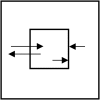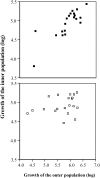Cellular communication through light
- PMID: 19340303
- PMCID: PMC2660427
- DOI: 10.1371/journal.pone.0005086
Cellular communication through light
Erratum in
- PLoS One. 2009;4(7). doi: 10.1371/annotation/8d99ccc5-cc76-44f4-b468-d63e42e0b9e1
Abstract
Information transfer is a fundamental of life. A few studies have reported that cells use photons (from an endogenous source) as information carriers. This study finds that cells can have an influence on other cells even when separated with a glass barrier, thereby disabling molecule diffusion through the cell-containing medium. As there is still very little known about the potential of photons for intercellular communication this study is designed to test for non-molecule-based triggering of two fundamental properties of life: cell division and energy uptake. The study was performed with a cellular organism, the ciliate Paramecium caudatum. Mutual exposure of cell populations occurred under conditions of darkness and separation with cuvettes (vials) allowing photon but not molecule transfer. The cell populations were separated either with glass allowing photon transmission from 340 nm to longer waves, or quartz being transmittable from 150 nm, i.e. from UV-light to longer waves. Even through glass, the cells affected cell division and energy uptake in neighboring cell populations. Depending on the cuvette material and the number of cells involved, these effects were positive or negative. Also, while paired populations with lower growth rates grew uncorrelated, growth of the better growing populations was correlated. As there were significant differences when separating the populations with glass or quartz, it is suggested that the cell populations use two (or more) frequencies for cellular information transfer, which influences at least energy uptake, cell division rate and growth correlation. Altogether the study strongly supports a cellular communication system, which is different from a molecule-receptor-based system and hints that photon-triggering is a fine tuning principle in cell chemistry.
Conflict of interest statement
Figures






Similar articles
-
Endogenous physical regulation of population density in the freshwater protozoan Paramecium caudatum.Sci Rep. 2017 Oct 23;7(1):13800. doi: 10.1038/s41598-017-14231-0. Sci Rep. 2017. PMID: 29062014 Free PMC article.
-
Planning Implications Related to Sterilization-Sensitive Science Investigations Associated with Mars Sample Return (MSR).Astrobiology. 2022 Jun;22(S1):S112-S164. doi: 10.1089/AST.2021.0113. Epub 2022 May 19. Astrobiology. 2022. PMID: 34904892
-
Clonal death associated with the number of fissions in Paramecium caudatum.J Cell Sci. 1980 Feb;41:177-91. doi: 10.1242/jcs.41.1.177. J Cell Sci. 1980. PMID: 7364881
-
New perspective in cell communication: potential role of ultra-weak photon emission.J Photochem Photobiol B. 2014 Oct 5;139:47-53. doi: 10.1016/j.jphotobiol.2014.03.004. Epub 2014 Mar 15. J Photochem Photobiol B. 2014. PMID: 24703082 Review.
-
Critical Overview of the Use of Ru(II) Polypyridyl Complexes as Photosensitizers in One-Photon and Two-Photon Photodynamic Therapy.Acc Chem Res. 2017 Nov 21;50(11):2727-2736. doi: 10.1021/acs.accounts.7b00180. Epub 2017 Oct 23. Acc Chem Res. 2017. PMID: 29058879 Review.
Cited by
-
Reprogramming cells and tissue patterning via bioelectrical pathways: molecular mechanisms and biomedical opportunities.Wiley Interdiscip Rev Syst Biol Med. 2013 Nov-Dec;5(6):657-76. doi: 10.1002/wsbm.1236. Epub 2013 Jul 29. Wiley Interdiscip Rev Syst Biol Med. 2013. PMID: 23897652 Free PMC article. Review.
-
Planetary Scale Information Transmission in the Biosphere and Technosphere: Limits and Evolution.Life (Basel). 2023 Aug 31;13(9):1850. doi: 10.3390/life13091850. Life (Basel). 2023. PMID: 37763254 Free PMC article.
-
Light activation of the isomerization and deprotonation of the protonated Schiff base retinal.J Mol Model. 2011 Oct;17(10):2539-47. doi: 10.1007/s00894-010-0927-x. Epub 2011 Jan 5. J Mol Model. 2011. PMID: 21207087
-
Biofield Science: Current Physics Perspectives.Glob Adv Health Med. 2015 Nov;4(Suppl):25-34. doi: 10.7453/gahmj.2015.011.suppl. Epub 2015 Nov 1. Glob Adv Health Med. 2015. PMID: 26665039 Free PMC article.
-
When microbial conversations get physical.Trends Microbiol. 2011 Mar;19(3):105-13. doi: 10.1016/j.tim.2010.12.007. Epub 2011 Jan 14. Trends Microbiol. 2011. PMID: 21239171 Free PMC article.
References
-
- Popp FA. Coupling of Fröhlich-Modes as a Basis of Biological Regulation. In: Hyland GJ, Rowlands P, editors. Herbert Fröhlich, FRS: A physicist ahead of his time. Liverpool: The University of Liverpool; 2006. pp. 139–175.
-
- Colli L, Facchini U, Guidotti G, Dugnani-Lonati R, Orsenigo M, et al. Further Measurements on the Bioluminescence of the Seedlings. Experientia (Basel) 1955;11:479–481.
-
- Mei W-P. Ultraweak Photon Emission from Synchronized Yeast (Saccharomyces cerevisiae) as a Function of the Cell Division Cycle. In: Popp FA, Li KH, Gu Q, editors. Recent Advances in BIOPHOTON RESEARCH and its Applications. Singapore: World Scientific; 1992. pp. 243–258.
-
- Popov GA, Tarusov BN. Nature of spontaneous luminescence of animal tissues. Biophysics. 1963;8:317–320. - PubMed
MeSH terms
LinkOut - more resources
Full Text Sources
Other Literature Sources
Research Materials

